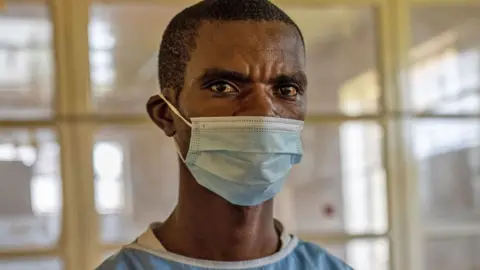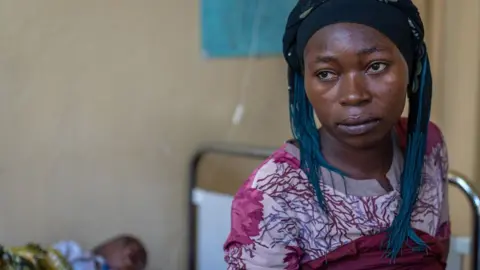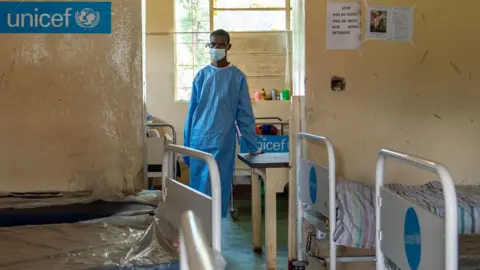BBC visits mpox clinic as WHO says cases ‘plateauing’

 BBC
BBCDoctors at the outbreak site in the eastern Democratic Republic of Congo have told the BBC that new infections have dropped significantly since a large number of vaccines were released last month.
The UN World Health Organization (WHO) confirmed to the BBC that new cases appear to be “increasing” in DR Congo, but warned that it is too early to tell the impact of the vaccine.
Mpox – formerly known as monkeypox – is a highly contagious disease and is believed to have killed at least 900 people in DR Congo this year.
The news comes ahead of a meeting where officials will decide whether the disease should continue to be considered a global public health emergency.
Some public health experts in Africa have warned that the disease is still spreading, as 19 countries on the continent have reported cases.
In September the BBC visited a clinic in Lwiro, a rural area about an hour’s drive outside the town of Bukavu in DR Congo’s eastern province of South Kivu.
The current cases have been linked to a new and more virulent type of mpox known as Clade 1b, which appears to spread more easily and cause severe disease.
Two months ago, we found the community hospital overwhelmed – there are long queues of infected patients, many forced to share beds or mattresses on the floor and doctors struggling to cope with the daily influx.
“At the moment, we cannot have more than 60 patients in the hospital,” nurse Emmanuel Fikiri, who has been at the forefront of the mpox crisis for months, told the BBC this week.
“This is because it has improved, we have been vaccinated against mpox and there is support from a few colleagues who have enabled us to take care of patients,” he said.
The last time Mr Fikiri spoke to the BBC he was able to speak briefly as he rushed to treat some of the nearly 200 patients who were crammed into the ward.
But he is now optimistic about the situation given that the vaccine is at its best – meaning new infections appear to have dropped dramatically.
Indeed when a BBC producer visited Lwiro Hospital earlier this week we found a calmer atmosphere: the long queues have gone and there are empty beds in the children’s ward.

DR Congo began its mpox vaccination program in October after the delivery of 265,000 doses donated by the international community.
More than 50,000 people have been vaccinated so far – as the rollout focuses on the most vulnerable communities, including towns and villages in eastern DR Congo.
But experts note that mpox appears to disproportionately affect children in DR Congo – and they are not vaccinated. It was only this week that the WHO approved a vaccine expected to come from Japan for children.
“Of the people affected, about 30% are children,” Dr. Jean Kaseya, head of the Africa Centers for Disease Control and Prevention (Africa CDC), told the BBC – explaining that children are “vectors of transmission”.
Another nurse at the Lwiro clinic, Jackson Murhula, warned that it is too early to say for sure that the disease has hit the community – although he is also happy to see things getting better.
“Recently it has started to decrease, because in the beginning we were getting 10 or 15 new cases a day but now we are only getting two or three a day,” he said.
“We cannot guarantee that we have completely stopped this disease, because the cases are still coming in, but it is not the same as before.”
Among the children being treated this week is three-year-old Atukuzwe Banissa.
He moans in pain, his eyes are closed and his face is covered in white spots left by healing wounds.
His mother, Julienne Mwinja, 25, says his symptoms started with teary eyes.
He took eye drops, but within a day, the little boy had sores on his mouth, face and body.
“He looked like he’d been scalded with hot water,” the mother-of-three told the BBC.
That is when he brought him to Lwiro Hospital where he was admitted for more than a week.
For doctors in Lwrio, it is good that people are used to coming to the clinic as soon as they get symptoms rather than going for months.

Dr Samuel Boland, the WHO head of mpox, told the BBC that more than 96% of all new cases are in DR Congo, Uganda and Rwanda.
While confirming that DR Congo has turned around, he warned that it is too soon to be sure that the outbreak is over.
“In the Democratic Republic of the Congo, to some extent, we have seen an increase in the number of mpox cases, but collectively, it is still the most affected country in the world,” he said.
In fact, more than 90% of those who died of mpox worldwide this year are in the DR Congo.
Although the exact figures are not known as it has been confirmed that only 77 people died in the laboratory as there are not many testing centers located in certain areas of the continent.
“Therefore, there is still a very strong need to ensure that we continue to intervene with speed and scale, even in areas where we see that there will be no increase in cases at this time,” said Dr. Boland.
“While overall, we can see a change in referrals in some areas, again, we’re still seeing an increase in others – so we’re not out of the woods yet.”
Vaccination programs have also begun elsewhere in Africa, including Nigeria and DR Congo’s neighbor Rwanda.
Dr Kaseya said the Africa CDC had not seen any significant changes from week to week in the past month in DR Congo and warned that it was too early to say that the mpox outbreak was under control.
With all vaccination efforts, strengthen surveillance and laboratory programs “probably in mid-January to February we will start to see a decrease in infection cases and deaths”.
WHO officials will now assess all the evidence on the speed of the disease’s spread before deciding to lower the level of global awareness.
You may also be interested in:
 Getty Images/BBC
Getty Images/BBCSource link




